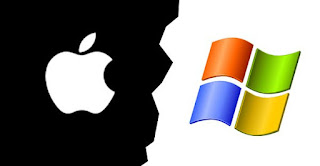apple vs microsoft
3. Apple vs Microsoft
The battle between these tech giants started with a simple question: who invented the graphical user interface (GUI)? The company that controls the interface of the next major operating system will have the ability to set the standards for application software, so it’s unsurprising that Apple tried to stop Windows from becoming a major operating system.
It seemed that although Microsoft helped develop Macintosh, Jean-Louis Gassée, who had taken over from Steve Jobs at the time, refused to allow Microsoft to use their software. Bill Gates pressed on nonetheless, deciding to add in features of its own to early prototypes of the Macintosh.
When Gassée noted the software, he was enraged. However, he didn’t want a lawsuit, and ended up agreeing to license the Mac’s visual displays. But Windows 2.0 turned out to be almost identical, and Gassée believed it to be a breach of contract, only having allowed their software to be used for 1.0 and not future versions.
So, without warning, Apple filed a lawsuit against Microsoft in 1988. Apple’s case included 189 contested visual displays that violated its copyright. This led to a six-year long battle.
In 1989, the court ruled that 179 of the 189 disputed displays were covered by the existing license. Furthermore, the other ten were not violations of Apple’s copyright due to the merger doctrine, where the idea–expression divide limits the scope of copyright protection by differentiating an idea from the manifestation of that idea.
Apple had agreed to license certain parts of its GUI to Microsoft for use in Windows 1.0, but when Microsoft made changes in Windows 2.0 adding overlapping windows and other features found in the Macintosh GUI, Apple filed suit. Apple added additional claims to the suit when Microsoft released Windows 3.0.
Apple claimed the "look and feel" of the Macintosh operating system, taken as a whole, was protected by copyright, and that each individual element of the interface (such as the existence of windows on the screen, the rectangular appearance of windows, windows could be resized, overlap, and have title bars) was not as important as all these elements taken together. After oral arguments, the court insisted on an analysis of specific GUI elements that Apple claimed were infringements. Apple listed 189 GUI elements; the court decided that 179 of these elements had been licensed to Microsoft in the Windows 1.0 agreement and most of the remaining 10 elements were not copyrightable—either they were unoriginal to Apple, or they were the only possible way of expressing a particular idea.
The district court ruled that it would require a standard of "virtual identity" between Windows and the Macintosh at trial in order for Apple to prove copyright infringement. Apple believed this to be too narrow of a standard and that a more broad "look and feel" was all that should be necessary at trial. As a result, both parties agreed that a jury trial was unnecessary given the rulings, and Apple filed an appeal to the Ninth Circuit Court of Appeals in order to have the district court's characterization overruled.
After the district court ruled in favor of Microsoft, Apple appealed the decision arguing that the district court only considered infringements on the individual elements of Apple's GUI, rather than the interface as a whole. The appeals court almost entirely affirmed the ruling of the district court, establishing that, "almost all the similarities spring either from the license or from basic ideas and their obvious expression... illicit copying could occur only if the works as a whole are virtually identical."
However, the circuit court did reverse the district court's decision not to award attorney's fees to Microsoft, clarifying and sending the case back to the district court to resolve the issue.
Citing Brown Bag Software v. Symantec Corp., the circuit court dissected the GUI in order to separate expression from ideas (as expression, but not ideas, are covered by copyright law).
The court outlined five ideas that it identified as basic to a GUI desktop: windows, icon images of office items, manipulations of icons, menus, and the opening and closing of objects. The court established that Apple could not make copyright claims based on these ideas and could only make claims on the precise expression of them.
The court also pointed out that many of Apple's claims fail on an originality basis. Apple admittedly licensed many of its representations from Xerox, and copyright protection only extends to original expression. Apple returned to its "complete look and feel" argument, stating that while the individual components were not original, the complete GUI was. The court rejected these arguments because the parts were not original.
The lawsuit was decided in Microsoft’s favor on August 24, 1993.




Comments
Post a Comment